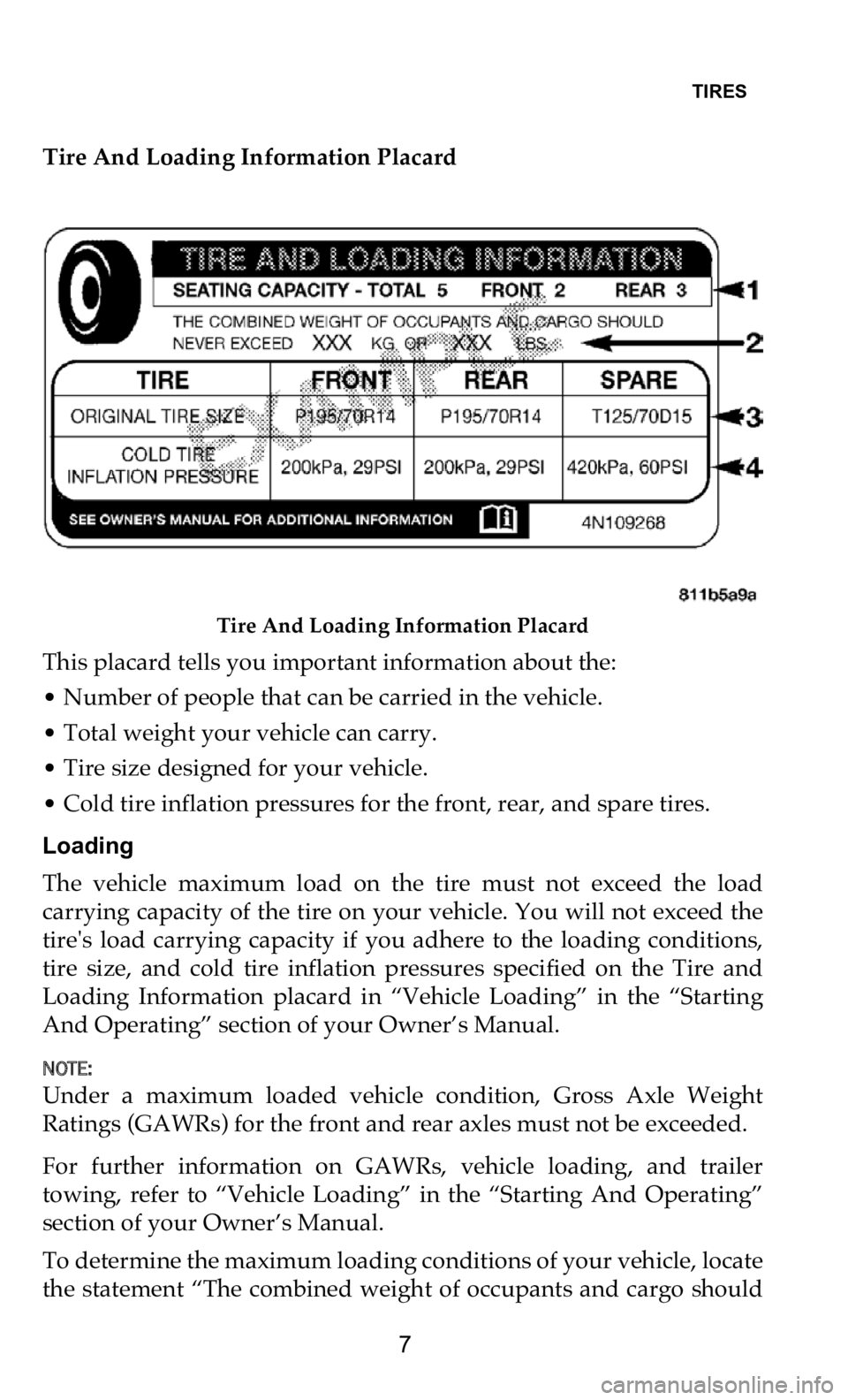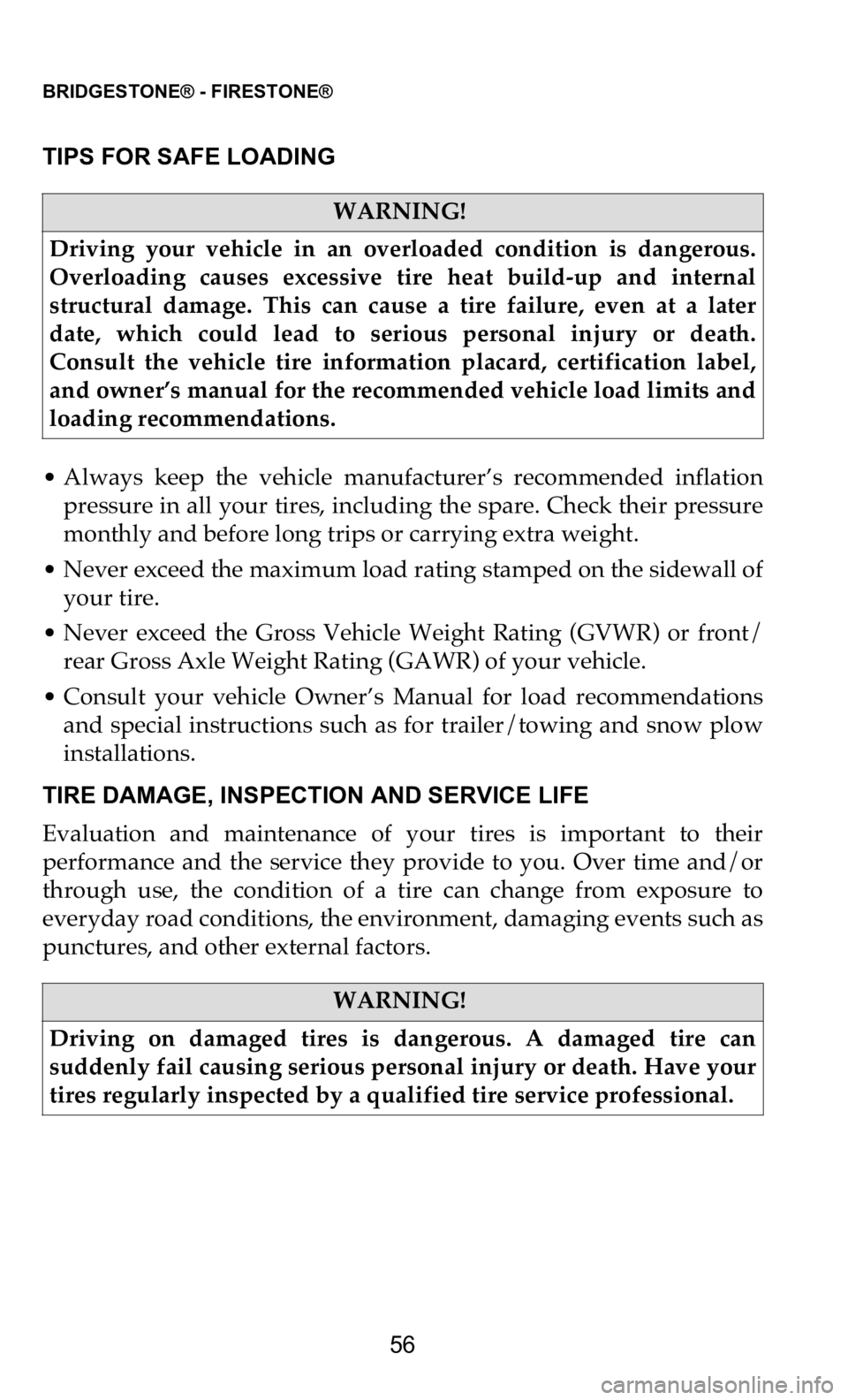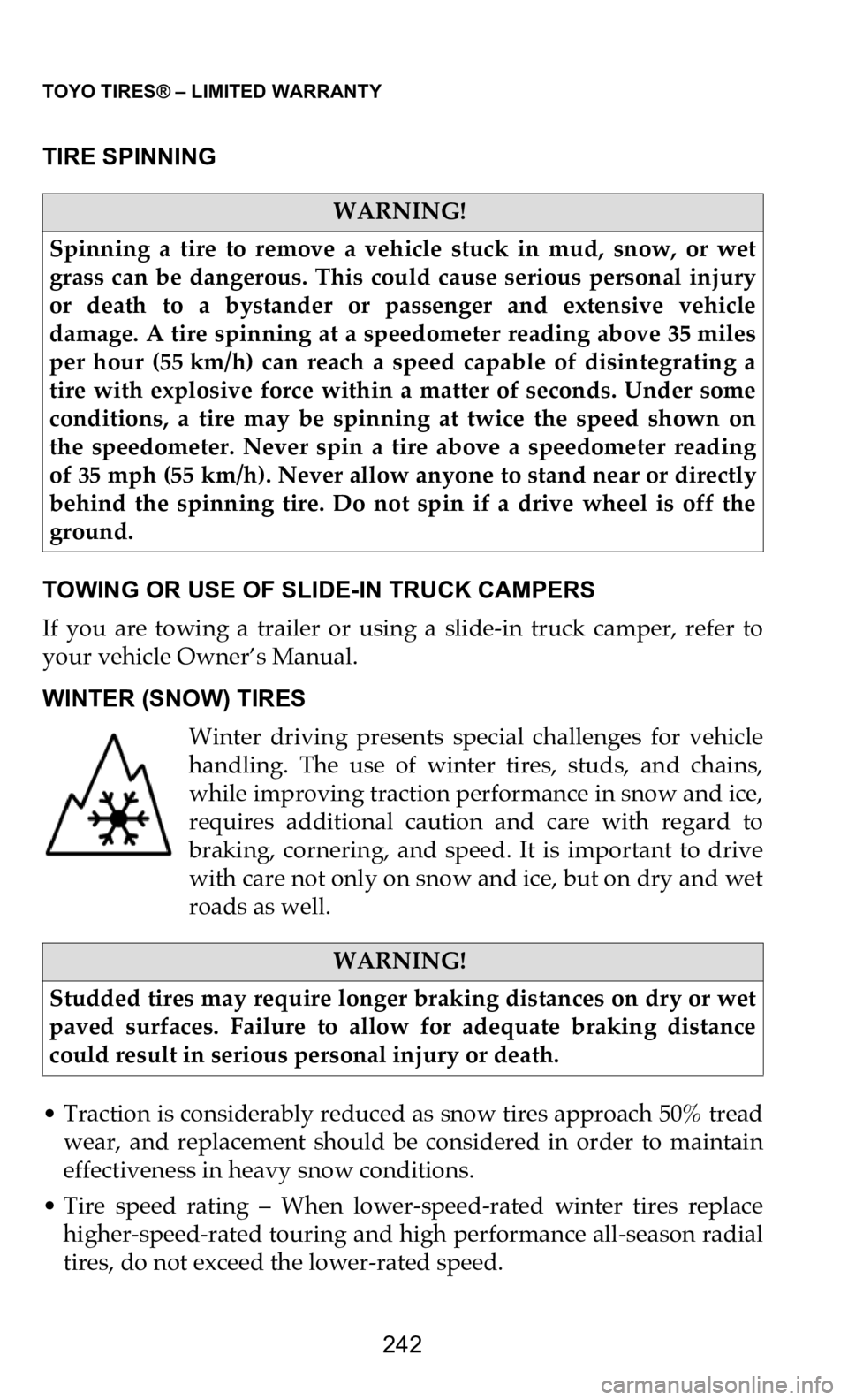trailer DODGE CHARGER 2021 Vehicle Warranty
[x] Cancel search | Manufacturer: DODGE, Model Year: 2021, Model line: CHARGER, Model: DODGE CHARGER 2021Pages: 262, PDF Size: 10.42 MB
Page 8 of 262

TIRES
7
Tire And Loading Information Placard
Tire And Loading Information Placard
This placard tells you important information about the:
• Number of people that can be carried in the vehicle.
•
Total weight your vehicle can carry.
•
Tire size designed for your vehicle.
•
Cold tire inflation pressures for the front, rear, and spare tires.
L
oading
The vehicle maximum load on the tire must not exceed the load
ca
rrying capacity of the tire on your vehicle. You will not exceed the
tire's load carrying capacity if you adhere to the loading conditions,
tire size, and cold tire inflation pressures specified on the Tire and
Loading Information placard in “Vehicle Loading” in the “Starting
And Operating” section of your Owner’s Manual.
NOTE:
Under a maximum loaded vehicle condition, Gross Axle Weight
Ra
tings (GAWRs) for the front and rear axles must not be exceeded.
For further information on GAWRs, vehicle loading, and trailer
to
wing, refer to “Vehicle Loading” in the “Starting And Operating”
section of your Owner’s Manual.
To determine the maximum loading conditions of your vehicle, locate
th
e statement “The combined weight of occupants and cargo should
Page 9 of 262

TIRES
8
never exceed XXX kg or XXX lbs” on the Tire and Loading Information
placard. The combined weight of occupants, cargo/luggage and
trailer tongue weight (if applicable) should never exceed the weight
referenced here.
Steps For Determining Correct Load Limit:
(1) Locate the statement “The combined weight of occupants and
ca
rgo should never exceed XXX kg or XXX lbs.” on your vehicle's
placard.
(2) Determine the combined weight of the driver and passengers that
wi
ll be riding in your vehicle.
(3) Subtract the combined weight of the driver and passengers from
XX
X kg or XXX lbs.
(4) The resulting figure equals the available amount of cargo and luggage
lo
ad capacity. For example, if “XXX” amount equals 1,400 lbs. and there
will be five 150 lb passengers in your vehicle, the amount of available
cargo and luggage load capacity is 650 lbs. (1,400-750 (5x150) = 650 lbs.)
(5) Determine the combined weight of luggage and cargo being loaded
on
the vehicle. That weight may not safely exceed the available cargo
and luggage load capacity calculated in Step 4.
(6) If your vehicle will be towing a trailer, load from your trailer will be
tr
ansferred to your vehicle. Consult this manual to determine how this
reduces the available cargo and luggage load capacity of your vehicle.
Metric Example For Load Limit
For example, if “XXX” amount equals 635 kg and there will be five 68 kg
pa
ssengers in your vehicle, the amount of available cargo and luggage
load capacity is 295 kg (635-340 (5x68) = 295 kg) as shown in step 4.
NOTE:
• If your vehicle will be towing a trailer, load from your trailer will be
transferred to your vehicle. The following table shows examples on
how to calculate total load, cargo/luggage, and towing capacities of
your vehicle with varying seating configurations and number and
size of occupants. This table is for illustration purposes only and
may not be accurate for the seating and load carrying capacity of
your vehicle.
• For the following example, the combined weight of occupants and
c
argo should never exceed 865 lbs (392 kg).
Page 14 of 262

TIRES
13
Tire Repair
If your tire becomes damaged, it may be repaired if it meets the
fo
llowing criteria:
• The tire has not been driven on when flat.
•
The damage is only on the tread section of your tire (sidewall
d
amage is not repairable).
• The puncture is no greater than a ¼ of an inch (6
mm).
Consult an authorized tire dealer for tire repairs and additional
in
formation.
Damaged Run Flat tires, or Run Flat tires that have experienced a loss
of
pressure should be replaced immediately with another Run Flat tire
of identical size and service description (Load Index and Speed
Symbol).
Run Flat Tires — If Equipped
Run Flat tires allow you the capability to drive 50 miles (80 km) at
50
mph (80 km/h) after a rapid loss of inflation pressure. This rapid
lo
ss of inflation is referred to as the Run Flat mode. A Run Flat mode
occurs when the tire inflation pressure is of/or below 14 psi (96 kPa).
Once a Run Flat tire reaches the run flat mode it has limited driving
capabilities and needs to be replaced immediately. A Run Flat tire is
not repairable.
It is not recommended to drive a vehicle loaded at full capacity or to
to
w a trailer while a tire is in the Run Flat mode.
See the Tire Pressure Monitoring System section for more information.
Tire Spinning
When stuck in mud, sand, snow, or ice conditions, do not spin your
ve
hicle's wheels above 30 mph (48 km/h) or for longer than 30 seconds
co
ntinuously without stopping.
Refer to “Freeing A Stuck Vehicle” in “In Case Of Emergency” in your
Ow
ner’s Manual for further information.
Page 36 of 262

BFGOODRICH® TIRES
35
DO NOT OVERLOAD - DRIVING ON ANY OVERLOADED TIRE
IS DANGEROUS
The maximum load rating of your tires is molded on the tire sidewall.
Do
not exceed this rating. Follow the loading instructions of FCA US
LLC and this will ensure that your tires are not overloaded. Tires
which are loaded beyond their maximum allowable loads for the
particular application will build up excessive heat that may result in
sudden tire destruction.
Do not exceed the Gross Axle Weight Rating (GAWR) for any axle on
yo
ur vehicle.
TRAILER TOWING
If you anticipate towing a trailer, you should visit any BFGoodrich®
ti
re retailer for advice concerning the correct size tire and pressures.
Tire size and pressures will depend upon the type and size of trailer
and hitch utilized, but in no case must the maximum cold inflation
pressure or tire load rating be exceeded. Check the tire decal and the
Owner’s Manual supplied by FCA US LLC for further
recommendations on trailer towing.
WHEEL ALIGNMENT AND BALANCING ARE IMPORTANT
FO
R SAFETY AND MAXIMUM MILEAGE FROM YOUR TIRES
CHECK HOW YOUR TIRES ARE WEARING AT LEAST ONCE
EA
CH MONTH
If your tires are wearing unevenly, such as the inside shoulder of the
ti
re wearing faster than the rest of the tread, or if you detect excessive
vibration, your vehicle may be out of alignment or balance. These
conditions not only shorten the life of your tires but adversely affect
the handling characteristics of your vehicle, which could be
dangerous. If you detect irregular wear or vibration, have your
alignment and balance checked immediately. Tires which have been
run underinflated will show more wear on the shoulders than in the
center of the tread.
TIRE MIXING
BFGoodrich® tires are radial tires and for best performance it is
r e
commended that the same size and type of tire be used on all four
wheel positions. Before mixing tires of different types in any
configuration on any vehicle, be sure to check the vehicle
manufacturer’s Owner‘s Manual for its recommendations.
Page 57 of 262

BRIDGESTONE® - FIRESTONE®
56
TIPS FOR SAFE LOADING
• Always keep the vehicle manufacturer’s recommended inflation
p
ressure in all your tires, including the spare. Check their pressure
monthly and before long trips or carrying extra weight.
• Never exceed the maximum load rating stamped on the sidewall of
y
our tire.
• Never exceed the Gross Vehicle Weight Rating (GVWR) or front/ r
ear Gross Axle Weight Rating (GAWR) of your vehicle.
• Consult your vehicle Owner’s Manual for load recommendations
a
nd special instructions such as for trailer/towing and snow plow
installations.
TIRE DAMAGE, INSPECTION AND SERVICE LIFE
Evaluation and maintenance of your tires is important to their
pe
rformance and the service they provide to you. Over time and/or
through use, the condition of a tire can change from exposure to
everyday road conditions, the environment, damaging events such as
punctures, and other external factors.
WARNING!
Driving your vehicle in an overloaded condition is dangerous.
Ov
erloading causes excessive tire heat build-up and internal
structural damage. This can cause a tire failure, even at a later
date, which could lead to serious personal injury or death.
Consult the vehicle tire information placard, certification label,
and owner’s manual for the recommended vehicle load limits and
loading recommendations.
WARNING!
Driving on damaged tires is dangerous. A damaged tire can
su
ddenly fail causing serious personal injury or death. Have your
tires regularly inspected by a qualified tire service professional.
Page 74 of 262

BRIDGESTONE® - FIRESTONE®
73
•If an unusual vibration or vehicle handling difficulty arises, stop
driving as soon as safely and reasonably possible. The tire may be
about to suddenly fail. Release the accelerator and gradually reduce
speed. The tire will need to be replaced before proceeding.
• If towing a trailer, stop driving as soon as safely and reasonably
p
ossible. In this condition, it is potentially dangerous to operate a
vehicle/trailer combination. If possible, disconnect the trailer and
proceed as noted above. Do not continue to tow any trailer until
proper tire service or replacement has been performed.
• Do not touch a tire recently run-low or run-flat (it may be very
h
ot). Allow the tire to cool before handling.
DISTANCE — HOW FAR YOU CAN DRIVE
Factors affecting run-flat or low tire pressure operating distance
in
clude vehicle speed, load, and maneuvering; the amount of inflation
pressure loss; the extent of any tire damage; and ambient temperature.
The tire may be marked on the sidewall with run-flat or low tire
pr
essure operating speed and/or distance limitations, which vary by
tire design and vehicle application (consult your vehicle owner’s
manual). By international standard, RFT tires have a baseline
limitation in run-flat mode of the following:
NOTE:
• Maximum distance values are determined under controlled condi -
tions, which may vary in actual use.
• Your mileage capability may be less, or more, depending on your
s
pecific operating conditions.
• If in doubt, do not exceed the 50
mile (80 km) limitation.
• Seek tire service as soon as possible to minimize tire damage.
Maximum Speed: 50 mph (80 km/h)
Maximum Distance: 50 miles (80 km)
Page 127 of 262

GOODYEAR® DUNLOP® TIRES
126
Furthermore, when operating a vehicle equipped with radial tires, it
is difficult to notice when a tire has gone flat or nearly flat since the
“feel” of the vehicle does not change significantly.
*Evidence of air loss or repeated underinflation always requires
ex
pert inspection to determine the source of leakage and tire
removal to determine repairability. To avoid injury, NEVER attempt
to reinflate a tire that has been run severely underinflated. Progressive
air loss may result from punctures, cuts, curbing, impacts or partial
bead unseating. Some fitment causes for air loss are (1) incomplete
bead seating, (2) bead tearing caused by a machine tool due to
insufficient lubrication or improper adjustment. Leaking valve core or
rubber valve components should be replaced when problems are
detected and whenever tires are replaced.
Always maintain inflation pressure at the level recommended by
t h
e vehicle manufacturer as shown on the vehicle placard, vehicle
certification label or in the vehicle Owner’s Manual:
Under inflation is the leading cause of tire failure and may result in
se
vere cracking, component separation or “blowout.” It reduces tire
load capacity, allows excessive sidewall flexing and increases rolling
resistance, resulting in heat and mechanical damage. Maintaining
proper inflation pressure is the single most important thing you can
do to promote tire durability and maximize tread life.
Over inflation increases stiffness, which may deteriorate ride and
ge
nerate unwanted vibration. Over inflation also increases the
chances of impact damage.
DON’T OVERLOAD YOUR VEHICLE
Check your vehicle Owner’s Manual to determine the load limits.
Ov
erloading your vehicle places stress on your tires and other critical
vehicle components. Overloading a vehicle can cause poor handling
or increased fuel consumption and may cause tire failure.
Overloading your tires can result in severe cracking, component
separation or “blowout.”
Never fit your vehicle with new tires that have less load capacity than
sh
own on the vehicle tire placard and remember that optimum rim
width is important for proper tire load distribution and function. The
maximum load capacity stamped on the sidewalls of P-Metric &
European Metric tires is reduced by 10% when used on a light truck,
utility vehicle or trailer. Never fit P-Metric or European Metric tires to
light trucks that specify LT-type replacement tires.
Page 173 of 262

MICHELIN®
172
DO NOT OVERLOAD - DRIVING ON ANY OVERLOADED TIRE IS
DANGEROUS
The maximum load rating of your tires is molded on the tire sidewall.
Do
not exceed this rating. Follow the loading instructions of FCA US
LLC for your vehicle and this will ensure that your tires are not
overloaded. Tires which are loaded beyond their maximum allowable
loads for the particular application will build up excessive heat that
may result in sudden tire destruction.
Do not exceed the gross axle weight rating for any axle on your
ve
hicle.
TRAILER TOWING
If you anticipate towing a trailer, you should visit any Michelin® tire
re
tailer for advice concerning the correct size tire and pressures. Tire
size and pressures will depend upon the type and size of trailer and
hitch utilized, but in no case must the maximum cold inflation
pressure or tire load rating be exceeded. Check the tire decal and the
owner’s manual supplied by FCA US LLC for your vehicle for further
recommendations on trailer towing.
MICHELIN® PAX® System Tires/Self-Supporting Zero Pressure
(Z
P) Tires and Trailer Towing
Operation of Pax® or ZP tires at low or zero air pressure with a trailer
in
tow, is dangerous and is not recommended. If the low pressure
warning indicator is activated when a trailer is in tow, stop, disconnect
the trailer, and do not continue to tow the trailer until the tire has been
repaired and re-inflated to the proper air pressure. If the tire cannot be
repaired, it must be replaced with a new full size, PAX®/ZP tire, and
inflated to the proper air pressure, before the trailer can be safely
towed again.
WHEEL ALIGNMENT AND BALANCING ARE IMPORTANT
FO
R SAFETY AND MAXIMUM MILEAGE FROM YOUR TIRES.
CHECK HOW YOUR TIRES ARE WEARING AT LEAST ONCE
EA
CH MONTH
If your tires are wearing unevenly, such as the inside shoulder of the
ti
re wearing faster than the rest of the tread, or if you detect excessive
vibration, your vehicle may be out of alignment or balance. These
conditions not only shorten the life of your tires but adversely affect
the handling characteristics of your vehicle, which could be
dangerous. If you detect irregular wear or vibration, have your
Page 243 of 262

TOYO TIRES® – LIMITED WARRANTY
242
TIRE SPINNING
TOWING OR USE OF SLIDE-IN TRUCK CAMPERS
If you are towing a trailer or using a slide-in truck camper, refer to
y o
ur vehicle Owner’s Manual.
WINTER (SNOW) TIRES Winter driving presents special challenges for vehicle
handling. The use of winter tires, studs, and chains,
wh
ile improving traction performance in snow and ice,
requires additional caution and care with regard to
braking, cornering, and speed. It is important to drive
with care not only on snow and ice, but on dry and wet
roads as well.
• T raction is considerably reduced as snow tires approach 50% tread
w
ear, and replacement should be considered in order to maintain
effectiveness in heavy snow conditions.
• Tire speed rating – When lower-speed-rated winter tires replace
h
igher-speed-rated touring and high performance all-season radial
tires, do not exceed the lower-rated speed.
WARNING!
Spinning a tire to remove a vehicle stuck in mud, snow, or wet
gr
ass can be dangerous. This could cause serious personal injury
or death to a bystander or passenger and extensive vehicle
damage. A tire spinning at a speedometer reading above 35 miles
pe
r hour (55 km/h) can reach a speed capable of disintegrating a
ti
re with explosive force within a matter of seconds. Under some
conditions, a tire may be spinning at twice the speed shown on
the speedometer. Never spin a tire above a speedometer reading
of 35 mph (55 km/h). Never allow anyone to stand near or directly
be
hind the spinning tire. Do not spin if a drive wheel is off the
ground.
WARNING!
Studded tires may require longer braking distances on dry or wet
pa
ved surfaces. Failure to allow for adequate braking distance
could result in serious personal injury or death.
Page 249 of 262

TOYO TIRES® – LIMITED WARRANTY
248
Tire installers should exercise extreme caution when replacing tires on
light trucks.
The maximum load capacity stamped on the sidewall of a P-metric tire
is
reduced by a factor of 1.1 when used on a light truck, a sport utility
vehicle, or a trailer.
When a P-metric or metric tire is installed on a light truck (SUV,
p i
ckup, minivan), the load rating is reduced by dividing by 1.1. (This
load reduction factor is prescribed by Federal Motor Vehicle Safety
Standards (FMVSS) and is based on the expectation that
passenger-type tires may experience more severe loading and usage
conditions when applied to light trucks.) For example, 305/50R20 has
a maximum load capacity of 3086 lbs. If this tire is fitted to a light
truck, the actual allowable load for the tire is 2805 lbs. (3086 lbs.
divided by 1.1).
Consult the load and inflation charts that can be found at
www.toyotires.com
. Contact Toyo Tires® Technical Service with any tire
replacement questions: 1-
800-442-8696 (Pacific Time) or
1-888-444-8696 (Eastern Time).
WARNING!
• P-metric and LT-metric tires are not necessarily interchangeable.
P
-metric and LT-metric tires follow completely different Load/
Inflation tables and are designed to carry different loads at
different pressures.
• LT-metric tires carry their load at higher inflation pressures and
d
o not always have adequate load capacity to replace P-metric
tires of the same size.
• After reducing a P-metric tire’s load rating by dividing by 1.1 for
f
itment on a Light Truck, the P-metric tire may not offer suffi -
cient load capacity to replace an LT-metric tire of the same size.
• Contact your Toyo Tires dealer or Toyo Tires Technical Service
f
or help determining how to choose a proper replacement size.
• Driving with underinflated or overloaded tires may result in
i
mmediate tire failure, which can cause an accident and could
lead to serious personal injury or death.